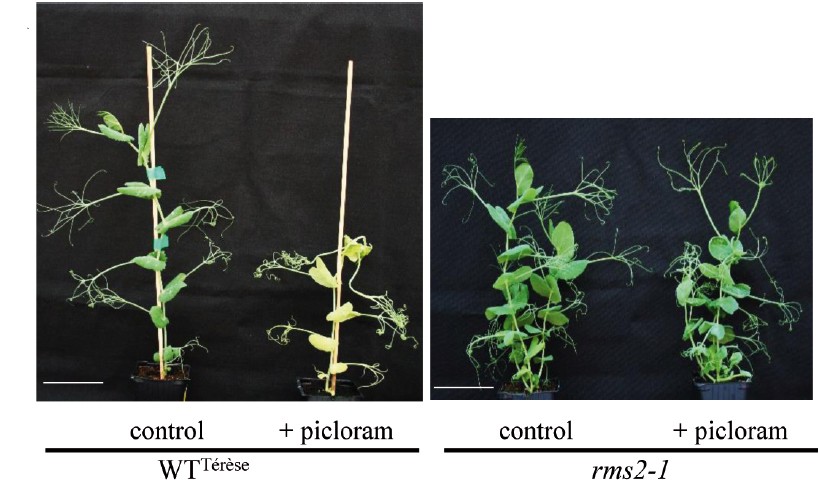博文
PLOS Genetics:豌豆中生长素与独脚金内酯的内稳态调节
||
The pea branching RMS2 gene encodes the PsAFB4/5 auxin receptor and is involved in an auxin-strigolactone regulation loop
Strigolactones (SLs; 独脚金内酯) are well known for their role in repressing shoot branching (分枝). In pea (豌豆), increased transcript levels of SL biosynthesis genes are observed in stems of highly branched SL deficient (ramosus1 (rms1) and rms5) and SL response (rms3 and rms4) mutants indicative of negative feedback control. In contrast, the highly branched rms2 mutant has reduced transcript levels of SL biosynthesis genes. Grafting studies and hormone quantification led to a model where RMS2 mediates a shoot-to-root feedback signal that regulates both SL biosynthesis gene transcript levels and xylem sap (木质部汁液) levels of cytokinin (细胞分裂素) exported from roots. Here we cloned RMS2 using synteny with Medicago truncatula and demonstrated that it encodes a putative auxin receptor of the AFB4/5 clade. Phenotypes similar to rms2 were found in Arabidopsis afb4/5 mutants, including increased shoot branching, low expression of SL biosynthesis genes and high auxin levels in stems. Moreover, afb4/5 and rms2 display a specific resistance to the herbicide picloram (除草剂青莠定). Yeast-two-hybrid experiments supported the hypothesis that the RMS2 protein functions as an auxin receptor. SL root feeding using hydroponics (水培) repressed auxin levels in stems and down-regulated transcript levels of auxin biosynthesis genes within one hour. This auxin down-regulation was also observed in plants treated with the polar auxin transport inhibitor NPA. Together these data suggest a homeostatic (自我平衡的) feedback loop (反馈回路) in which auxin up-regulates SL synthesis in an RMS2-dependent manner and SL down-regulates auxin synthesis in an RMS3 and RMS4-dependent manner.
独脚金内酯(SL)在植物会抑制分枝的形成。在豌豆种,在茎高度分枝的突变体rms1和rms5中观察到SL生物合成基因转录水平的上调,同时在SL响应突变体rms3和rms4中也观察到类似想象,证明了存在一个负反馈调控。相反,在高度分枝的rms2突变体中,SL生物合成基因转录水平降低。嫁接试验和激素定量显示RMS2介导芽向根的反馈信号调控SL生物合成基因的转录水平及木质部汁液中根释放的细胞分裂素水平。作者根据苜蓿中的RMS2基因克隆了豌豆中的RMS2基因,分析显示其编码一个AFB4/5类生长素受体蛋白。拟南芥的afb4/5突变体有着与豌豆rms2突变体类似的表型,包括分枝的增加、SL生物合成基因低的转录水平及茎的高生长素水平。此外,afb4/5和rms2突变体还同样对除草剂青莠定有特异性的抗性。酵母双杂试验显示RMS2蛋白就是一个生长素受体。利用水培法进行根系SL处理会抑制茎中生长素的水平,并在一个小时之内下调生长素生物合成基因的表达。这些下调表达的基因在使用生长素极性运输抑制剂NPA处理的植株中同样会下调表达。综上,生长素通过依赖RMS2上调表达SL的生物合成,而SL又通过RMS3和RMS4下调表达生长素的生物合成,以此形成一个内稳态的反馈回路。
IRNA Branching control in plants研究团队带头人,主要方向为独脚金内酯在植物分枝中的作用。2008年在Nature上以长文发表《Strigolactone inhibition of shoot branching》,doi号10.1038/nature07271。
doi: https://doi.org/10.1371/journal.pgen.1007089
https://blog.sciencenet.cn/blog-3158122-1090258.html
上一篇:J EXP BOT:叶片衰老相关表观遗传调控综述
下一篇:Plant Cell:植物激素与昼夜节律共同调控拟南芥下胚轴伸长
全部作者的其他最新博文
- • Plant Physiology:CsMADS3促进柑果中的叶绿素降解和类胡萝卜素合成(华中农业大学)
- • Molecular Plant:LBD11-ROS反馈调节作用于拟南芥的维管形成层增殖和次生生长(浦项科技大学)
- • Science Advances:根结线虫通过调控植物的CLE3-CLV1模块,促进侵染进程(日本熊本大学)
- • Nature Communications:油菜素内酯参与植物营养生长期转变的分子机制解析(浙江农林大学)
- • Current Biology:光合作用产生的蔗糖驱动侧根“生物钟”(德国弗莱堡大学)
- • PNAS:花同源异型基因在叶中被抑制、花中被激活的分子机制(南卡罗来纳大学)

